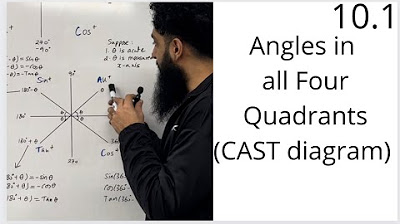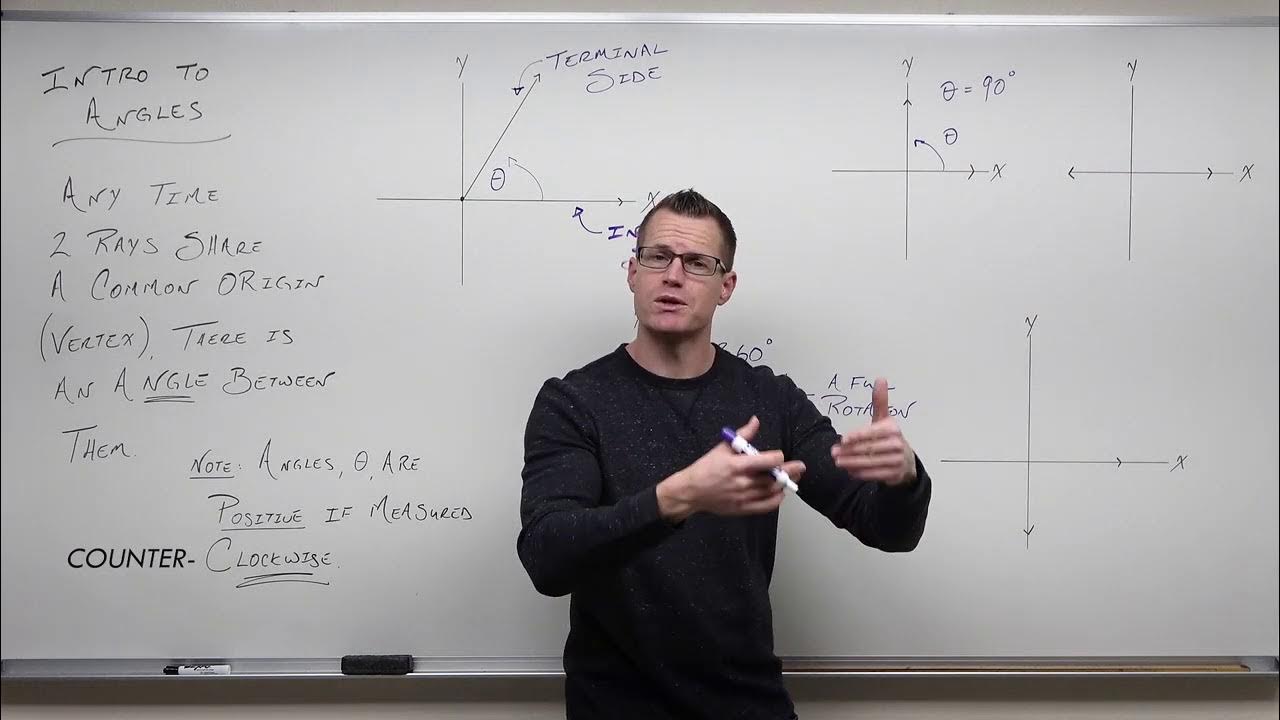Introduction to Angles
TLDRThis educational video script delves into the fundamentals of geometry, focusing on angles. It explains that an angle is formed by two rays sharing a common endpoint, known as the vertex. The script clarifies the difference between a segment, a ray, and a line, and defines various types of angles, including acute, right, straight, and obtuse angles. It also discusses angles in standard position, the significance of quadrants, and the properties of angles in relation to the coordinate system. Additionally, it provides an overview of how to plot both positive and negative angles, and briefly mentions an online trigonometry course available on Udemy for further learning.
Takeaways
- 📐 An angle is formed by two rays sharing a common endpoint, known as the vertex.
- 📏 A line segment has two endpoints, while a ray has one endpoint and extends infinitely in one direction.
- 🔍 Angles are measured from the initial side to the terminal side, and can be positive or negative depending on the direction of rotation.
- ⚖️ Acute angles are less than 90 degrees, right angles are exactly 90 degrees, obtuse angles are greater than 90 degrees, and straight angles are 180 degrees.
- 📊 Angles are considered in standard position when the vertex is at the origin and the initial side lies along the positive x-axis.
- 🌐 Quadrants in the coordinate system are numbered from 1 to 4, each with specific signs for x and y values.
- 📈 Trigonometric functions like sine and cosine have different signs in different quadrants, which is crucial for understanding their behavior.
- 📝 The instructor offers a comprehensive online trigonometry course on Udemy, covering a wide range of topics from basics to advanced concepts.
- 🎨 Drawing angles in standard position involves placing the initial side on the x-axis and adjusting the terminal side to the correct angle measure.
- 🔢 Positive and negative angles can be plotted on the coordinate system by understanding the direction of rotation and the corresponding quadrant.
- 🔄 Coterminal angles, like 0 and 360 degrees, point to the same location on the graph but have different measures.
Q & A
What is an angle in geometry?
-An angle in geometry is formed by two rays that share a common endpoint, known as the vertex of the angle. The first ray is called the initial side, and the second ray is called the terminal side.
What is the difference between a line, a ray, and a segment?
-A segment connects two points and has two endpoints. A ray has one endpoint and extends infinitely in one direction. A line has no endpoints and extends infinitely in both directions.
What is the standard position of an angle?
-An angle is said to be in its standard position if the vertex is at the origin and the initial side lies along the non-negative x-axis.
How is the direction of rotation related to the sign of the angle?
-If the rotation from the initial side to the terminal side is in the counterclockwise direction, the angle is positive. If the rotation is in the clockwise direction, the angle is negative.
What are the four types of angles mentioned in the script, and how are they defined?
-The four types of angles are: acute angle (less than 90 degrees), right angle (exactly 90 degrees), straight angle (exactly 180 degrees), and obtuse angle (greater than 90 degrees but less than 180 degrees).
What are the four quadrants of a coordinate system, and how are they defined by the signs of x and y?
-The four quadrants are: first quadrant (x positive, y positive), second quadrant (x negative, y positive), third quadrant (x negative, y negative), and fourth quadrant (x positive, y negative).
How are sine and cosine functions related to the quadrants and the signs of their values?
-Sine is associated with the y values and is positive in quadrants one and two. Cosine is associated with the x values and is positive in quadrants one and four.
What are the angles associated with the x and y axes on a coordinate system?
-The angle on the x-axis is 0 degrees, on the positive y-axis it is 90 degrees, on the negative x-axis it is 180 degrees, and on the negative y-axis it is 270 degrees.
What does it mean for two angles to be coterminal?
-Two angles are coterminal if they land on the same position on the graph, meaning they point to the same direction even though they have different numerical values. For example, 0 and 360 degrees are coterminal.
How can you draw an angle of 45 degrees in standard position?
-To draw a 45-degree angle in standard position, first draw the x and y axes. The initial side is on the x-axis, and the terminal side is drawn 45 degrees above the x-axis, bisecting the angle between 0 and 90 degrees.
How do you determine the position of angles like 135, 210, 300, and 330 degrees in standard position?
-Angles 135, 210, 300, and 330 degrees are positioned in their respective quadrants based on their degree measurements: 135 degrees is in quadrant two (between 90 and 180 degrees), 210 degrees is in quadrant three (between 180 and 270 degrees), 300 degrees is in quadrant four (between 270 and 360 degrees), and 330 degrees is close to 360 degrees.
How do you plot negative angles on a coordinate system?
-To plot negative angles, rotate in the clockwise direction from the positive x-axis. For example, negative 60 degrees is just above negative 90 degrees, negative 135 degrees is between negative 90 and negative 180 degrees in quadrant three, negative 180 degrees is directly opposite the positive x-axis, and negative 240 degrees is between negative 180 and negative 270 degrees in quadrant two.
Outlines
📐 Understanding Angles and Their Basic Geometry
This paragraph introduces the concept of angles in geometry, explaining that an angle is formed by two rays sharing a common endpoint known as the vertex. It distinguishes between different types of lines: a segment with two endpoints, a ray with one endpoint extending infinitely in one direction, and a line with no endpoints extending infinitely in both directions. The paragraph explains the orientation of angles in standard position, with the initial side on the x-axis and the terminal side's position determining the angle's measure and sign. It also covers different types of angles: acute (less than 90 degrees), right (exactly 90 degrees), straight (180 degrees), and obtuse (greater than 90 degrees). The importance of understanding angle positions in the four quadrants of the Cartesian coordinate system is emphasized, especially for their relevance to trigonometric functions like sine and cosine.
📈 Trigonometry Course Overview and Drawing Angles in Standard Position
The speaker provides an overview of their complete online trigonometry course available on Udemy, which includes various topics such as angle introduction, converting degrees to radians, linear and angular speed problems, arc length, unit circle, trigonometric function evaluation, right triangle trigonometry, graphing sine and cosine functions, and more. The paragraph then transitions into a practical demonstration of how to draw angles in standard position, using the example of a 45-degree angle. The process involves drawing the x and y axes, placing the angle's vertex at the origin, and aligning the initial side along the x-axis. The terminal side's position relative to the initial side determines the angle's measure. Additional examples of drawing 30, 60, 135, 210, 300, and 330 degrees are given, with instructions to practice plotting these angles and understanding their positions in the respective quadrants.
🔍 Plotting Positive and Negative Angles on the Coordinate System
This paragraph teaches how to plot both positive and negative angles on the rectangular coordinate system. It explains the concept of coterminal angles, which are different angles that share the same terminal side, such as 0 and 360 degrees. The speaker guides through plotting various angles, including 135, 210, 300, and 330 degrees, and explains how to determine their positions relative to the positive x-axis and the quadrants they fall into. The paragraph also covers negative angles, detailing how to plot -60, -135, -180, and -240 degrees by rotating in the clockwise direction. It emphasizes the difference between clockwise and counterclockwise rotation and how it affects the angle's sign, with clockwise rotations resulting in negative angles and counterclockwise rotations in positive ones.
Mindmap
Keywords
💡Angle
💡Ray
💡Vertex
💡Acute Angle
💡Right Angle
💡Straight Angle
💡Obtuse Angle
💡Quadrants
💡Trigonometry
💡Unit Circle
💡Coterminal Angles
Highlights
An angle is formed by two rays that share a common endpoint, known as the vertex.
A ray is a line with one endpoint that extends infinitely in one direction.
The initial side of an angle is the first ray, and the terminal side is the second ray.
Angles can be measured from the initial side to the terminal side, often denoted by theta.
An angle is in standard position if its vertex is at the origin and the initial side lies along the x-axis.
Positive angles are those measured in a counterclockwise direction from the initial side to the terminal side.
Negative angles are measured in a clockwise direction.
An acute angle is less than 90 degrees but greater than 0 degrees.
A right angle measures exactly 90 degrees.
A straight angle is equivalent to a straight line and measures 180 degrees.
An obtuse angle is greater than 90 degrees.
The four quadrants of a coordinate system are defined by the signs of x and y coordinates.
Sine is associated with y values and cosine with x values in the context of quadrants.
Angles on the x-axis are 0 degrees, and on the y-axis are 90 degrees or 270 degrees depending on direction.
Angles of 0 and 360 degrees are coterminal, meaning they point to the same location on the graph.
The instructor offers a complete online trigonometry course on Udemy.
The course includes lectures on angles, converting degrees to radians, and trigonometric functions.
How to draw angles in standard position is demonstrated with examples of 45, 30, and 60 degrees.
Angles of 135, 210, 300, and 330 degrees are plotted to show their positions in different quadrants.
Negative angles are plotted by rotating in a clockwise direction, with examples of -60, -135, -180, and -240 degrees.
Transcripts
Browse More Related Video

ANGLES IN A UNIT CIRCLE || PRE-CALCULUS

Types of Angles and Angle Relationships

Trigonometry: How to use the ASTC Rule | The Quadrant | CAST

Edexcel AS Level Maths: 10.1 Angles in all Four Quadrants (CAST diagram - Trigonometry)

REFERENCE ANGLES || PRE-CALCULUS

Introduction to Angles (Precalculus - Trigonometry 1)
5.0 / 5 (0 votes)
Thanks for rating: